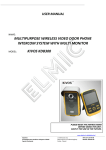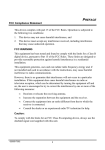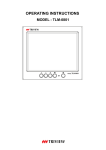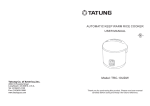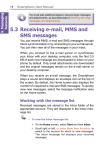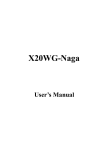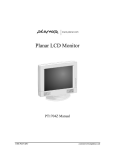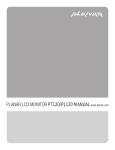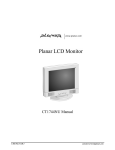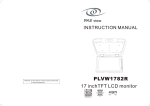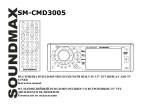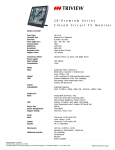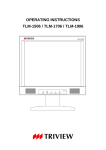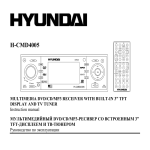Download Tatung TLM TLM-1705 User's Manual
Transcript
OPERATING INSTRUCTIONS TLM-1705 / TLM1905 PREFACE FCC Compliance Statement This device complies with part 15 of the FCC Rules. Opeartion is subjected to the following two conditions: 1. 2. This device may not cause harmful interference, and This device must accept any interference received, including interference that may cause undesired operation. FCC WARNING This equipment has been tested and found to comply with the limits for a Class B digital device, pursuant to Part 15 of the FCC Rules. These limits are designed to provide reasonable protection against harmful interference in a residential installation. This equipment generates, uses and can radiate radio frequency energy and, if not installed and used in accordance with the instructions, may cause harmful inerference to radio communications. However, there is no guarantee that interference will not occur in a particular installation. If this equipment does cause harmful interference to radio or television reception, which can be determined by turning the equipment off and on, the user is encouraged to try to correct the interference by one or more of the following measures: • Reorient or relocate the receiving antenna. • Increase the separation between the equipment and the receiver. • Connect the equipment into an outlet different from that to which the receiver is connected. • Consult the dealer or an experienced radio/TV technician for help. Caution: To comply with the limits for an FCC Class B computing device, always use the shielded signal cord supplied with this unit. i The Federal Communications Commission warns that changes or modifications of the unit not expressly approved by the party responsible for compliance could void the user’s authority to operate the equipment. CE mark for Class B ITE (Following European standard EN55022/1998; EN610003-2/1995; EN61000-3-3/1995, EN55024/1998, EN60950/1992+A1+A2+A3+A4+A11) Radio Frequency Interference Statement Warning: This is a Class B product. In a domestic environment, this product may cause radio interference in which case the user may be required to take adequate measures. Canadian Doc Notice For Class B Computing Devices This digital apparatus does not exceed the Class B limits for radio noise emissions from digital apparatus as set out in the Radio Interference Regulation of the Canadian Department of Communications. “Le présent appareil numérique n’èmet pas de bruits radioélectriques dépassant les limites applicables aux appareils numériques de la class B prescrites dans le Règlement sur le brouillage radioélectrique édicté par le ministère des Communications du Canada” ii Important Operating Instructions Please read the following instructions carefully. This manual should be retained for future use. 1. 2. 3. 4. 5. 6. 7. 8. 9. To clean the LCD monitor screen, first, make sure the monitor is in the power off mode. Unplug the monitor from its power source before cleaning it. Do not spray liquid cleaners directly onto the unit. Without applying excessive pressure, clean the screen with a slightly dampened rag. Do not place your LCD monitor near a window. Exposing the monitor to rain, water, moisture, or sunlight can severely damage it. Do not place anything on top of the monitor-to-PC signal cord. Make sure the cord is placed in an area where it will not be stepped on. Do not apply pressure to the LCD screen. Excessive pressure may cause permanent damage to the display. Do not remove the cover or attempt to service this unit by yourself. You may void the warranty. Servicing of any nature should be performed only by an authorized technician. Safe storage of the LCD monitor is in a range of minus 20 to plus 60 degrees Celsius. Storing your LCD monitor outside this range could result in permanent damage. Immediately unplug your monitor and call an authorized technician when: • The power or monitor-to-PC signal cord is frayed or damaged. • Liquid has been spilled into the monitor, or it has been exposed to rain. • The monitor has been dropped or the case has been damaged. Only with use of supplied adaptor, in case of loss or replacement contact the retailer or service center. If you lost the power cord that we given, you must to purchase a same configuration/type of power cord (with ground-connection) Japan: VCTF type, 3 wires or with ground-wire, T-mark approval is required. U.S.:VW-1; 18AWG X 3C; SVT with national approval as UL and/or CSA approval/number(s) Europe:VDE/ÖVE and/or KEMA approval; H05VV-F, 3G, 0.75mm2, or equivalent. Above power cord should bear with the type and manufacturer name on. iii Introduction CONTENTS PREFACE .....................................................................................................................I CHAPTER 1................................................................................................................. 1 Unpacking 1 Identifying Components 2 The LCD Multimedia Monitor — Front View 2 The LCD Multimedia Monitor — Rear View 2 Adjusting the Tilting Angle 3 Raising Your Monitor to an Upright Position and Adjusting Monitor Angle4 Power Management System 5 CHAPTER 2................................................................................................................. 6 LCD Multimedia Monitor Control Panel 6 Adjusting the Monitor’s Display 7 OSD Main Menu 7 Hot-Key Buttons for Quick Adjustment of Monitor Settings. (〝AUTOADJUST〞hot-key is effective only when analog input signal is selected for application) 16 APPENDIX A............................................................................................................. 17 Troubleshooting Procedures 17 APPENDIX B ............................................................................................................. 19 LCD Monitor Specifications 19 APPENDIX C............................................................................................................. 21 iv CHAPTER 1 The LCD Multimedia Monitor Unpacking After you unpack your LCD multimedia monitor, make sure the following items are included in the box and in good condition: Standard Item • LCD multimedia monitor • Monitor-to-PC analog signal cable (15-pin) • Monitor-to-PC digital signal cable (24-pin) – (Optional) • Power cord • Addendum • User’s manual • 1.5M Stereo Jack audio cable If you find that any of these items are missing or appear damaged, contact your dealer immediately. Do not throw away the packing material or shipping carton in case you need to ship or store the LCD multimedia monitor in the future. 1 Identifying Components The LCD Multimedia Monitor — Front View Figure 1-1: The LCD multimedia Monitor Front View 1. Power-On Indicator 2. This LED indicator stays lit when the power is on and blinks when the LCD multimedia monitor is in power saving mode. Monitor Stand 3. LCD Screen 4. LCD Multimedia Monitor Control Panel Refer to Chapter 2 for a detailed. The LCD Multimedia Monitor — Rear View Figure 1-2: LCD Multimedia Monitor Rear View 2 1. Audio Line-in 2. AC Power Jack 3. VGA (Analog) Cable With 15-Pin D-Sub VGA Connector (Male) 4. S-Video connector 5. AV connector 6. Digital VGA (DVI) Cable Connector (Optional) Adjusting the Tilting Angle The LCD multimedia monitor’s angle settings range from -3° to 20°. See Figure 1-3. Figure 1-3: Tilting the Monitor 3 Raising Your Monitor to an Upright Position and Adjusting Monitor Angle 4 Power Management System The LCD multimedia monitor complies with the VESA DPMS power management proposal. When the LCD multimedia monitor is in power saving mode or detects an incorrect timing, the monitor screen will be blank and the power LED indicator starts blinking. 5 CHAPTER 2 The Display Controls LCD Multimedia Monitor Control Panel Figure 2-1: The LCD Monitor Panel 1. OSD Menu Button Press this button to pop up the OSD (On-Screen Display) menu. This button is also a Function Select button. 2. Adjustment Control Buttons These two buttons allow you to adjust the selected control functions in the OSD. 3. Function Select Buttons These two buttons allow you to select the control functions in the OSD. Press either button to scroll through the main menu and submenu items. 4. Power Switch Push the power switch to turn the monitor on and off. This switch is also a hot-key button to close the OSD menu while the OSD appears. 6 Adjusting the Monitor’s Display OSD Main Menu To access the OSD main menu, press the OSD Menu button. Use the Function Select buttons to scroll between the OSD main menu options. The option that is currently selected is blinking. Pressing one of adjustment control buttons causes the following screen to appear: Figure 2-2: The OSD Main Menu ◆ANALOG MODE: When analog signal input is selected. MONITOR-CONTROL Option The Monitor-Control option allows you to adjust the LCD monitor’s display settings. Press Adjustment control button to display the submenu. AUTO-ADJUST: Press the adjustment control button to let the monitor determine and select the settings that are most appropriate for your system requirements. 7 H-POSITION: To move the LCD monitor’s display left or right on a horizontal plane. V-POSITION: To move the LCD monitor’s display up or down on a vertical plane. PHASE: To adjust the focus and clarity of the display. CLOCK: To adjust the display pixel alignment. RESET: To reset all of the Monitor-Control submenu settings to the factory default. GRAPHIC/TEXT: Press the adjustment control button to switch between text and graphic display modes. PORT-SELECT: To select video source by pressing adjustment button to switch DVI (Optional), analog, video (CVBS) or S-Video signal input. EXIT: To exits the Monitor-Control submenu. OSD-CONTROL Option The OSD-Control menu option lets you adjust the position of the OSD on the screen. Press the Adjustment control button to display the submenu. Use the Function Select buttons to select one of the following submenu options: OSD-H-POSITION: To change the position of the OSD on a horizontal plane. OSD-V-POSITION: To change the position of the OSD on a vertical plane. OSD-TIMER: The OSD menu display time can be set at 5, 10, 15, 20, 25 or 30 seconds. 8 EXIT: To exit the OSD-Control submenu. GRAPHIC-CONTROL Option The Graphic-Control option lets you make adjustments that effect the contrast, brightness and color of the LCD monitor’s display. Press the Adjustment control button to display the submenu. CONTRAST: To adjust the contrast level of the display screen. BRIGHTNESS: To adjust the light level on the display screen. COLOR: To select the LCD monitor’s color display. The available options are 9300, 6500 and User. Selecting the user option lets you make individual adjustments to the R, G and B items. GAIN R, G and B ADJUST: To make individual adjustments to the Red, Blue, Green (RGB) gain for the color temperature. AUTO LEVEL: To adjust automatically to perfect the white balance display. RESET: To reset all of the Graphic-Control submenu settings to the factory default. EXIT: To exit the Graphic-Control submenu. MISC-CONTROL Option The Misc-Control menu option lets you select the OSD display language, adjust the audio volume setting and view system information. 9 Press the Adjustment control button to display the submenu. LANGUAGE: The supported languages include German, English, French, Spanish, Italian and Japanese. AUDIO VOLUME: To increase or decrease the volume of the LCD monitor’s sound system. INFORMATION: To indicate display mode timings and firmware version. EXIT: To exit the Misc-Control submenu. OSD EXIT Option Use the OSD Exit item to close the OSD menu. The OSD will disappear by itself if left inactive. ◆DIGITAL MODE (Optional): When DVI signal input is selected. MONITOR-CONTROL Option Press Adjustment control button to display the submenu. PORT-SELECT: To select video source by pressing adjustment button to switch DVI (Optional), analog, video (CVBS) or S-Video signal input. EXIT: To exits the Monitor-Control submenu. 10 OSD-CONTROL Option The OSD-Control menu option lets you adjust the position of the OSD on the screen. Press the Adjustment control button to display the submenu. Use the Function Select buttons to select one of the following submenu options: OSD-H-POSITION: To change the position of the OSD on a horizontal plane. OSD-V-POSITION: To change the position of the OSD on a vertical plane. OSD-TIMER: The OSD menu display time can be set at 5, 10, 15, 20, 25 or 30 seconds. EXIT: To exit the OSD-Control submenu. GRAPHIC-CONTROL Option The Graphic-Control option lets you make adjustments that effect the contrast, brightness and color of the LCD monitor’s display. Press the Adjustment control button to display the submenu. CONTRAST: To adjust the contrast level of the display screen. BRIGHTNESS: To adjust the light level on the display screen. RESET: To reset all of the Graphic-Control submenu settings to the factory default. EXIT: To exit the Graphic-Control submenu. 11 MISC-CONTROL Option The Misc-Control menu option lets you select the OSD display language, adjust the audio volume setting and view system information. Press the Adjustment control button to display the submenu. LANGUAGE: The supported languages include German, English, French, Spanish, Italian and Japanese. AUDIO VOLUME: To increase or decrease the volume of the LCD monitor’s sound system. INFORMATION: To indicate display mode timings and firmware version. EXIT: To exit the Misc-Control submenu. OSD EXIT Option Use the OSD Exit item to close the OSD menu. The OSD will disappear by itself if left inactive. ◆VIDEO or S-VIDEO MODE: When Video or S-Video signal input is selected. MONITOR-CONTROL Option Press Adjustment control button to display the submenu. PORT-SELECT: To select video source by pressing adjustment button to switch DVI (Optional), analog, video (CVBS) or S-Video signal input. 12 EXIT: To exits the Monitor-Control submenu. OSD-CONTROL Option The OSD-Control menu option lets you adjust the position of the OSD on the screen. Press the Adjustment control button to display the submenu. Use the Function Select buttons to select one of the following submenu options: OSD-H-POSITION: To change the position of the OSD on a horizontal plane. OSD-V-POSITION: To change the position of the OSD on a vertical plane. OSD-TIMER: The OSD menu display time can be set at 5, 10, 15, 20, 25 or 30 seconds. EXIT: To exit the OSD-Control submenu. VIDEO-CONTROL Option Press the Adjustment control button to display the submenu. CONTRAST: To adjust the contrast level of the display screen. BRIGHTNESS: To adjust the light level on the display screen. HUE: To adjust the hue level you prefer. 13 SATURATION: To adjust the color level you prefer. SHARPNESS: Press the adjustment button to optimize the sharpness for your specific application. RESET: To reset all of the Video-Control submanu settings to the factory default. EXIT: To exit the Video-Control submenu. MISC-CONTROL Option The Misc-Control menu option lets you select the OSD display language, adjust the audio volume setting and view system information. Press the Adjustment control button to display the submenu. LANGUAGE: The supported languages include German, English, French, Spanish, Italian and Japanese. AUDIO VOLUME: To increase or decrease the volume of the LCD monitor’s sound system. INFORMATION: To indicate display mode timings and firmware version. EXIT: To exit the Misc-Control submenu. OSD EXIT Option Use the OSD Exit item to close the OSD menu. The OSD will disappear by itself if left inactive. 14 Note: 1. No Video When the monitor is ON and there is no Video signal received, the following message will be displayed. 2. Signal out of monitor’s supported range (Please refer to Addendum) When the frequency range of the signal is out of the monitor’s specifications, the display will show the following message on two cases: Case 1: The incoming frame rate is higher than 75Hz. In this case, the screen display may not be centered and a warning message appears. Case 2: The incoming resolution is higher than 1280x1024. In this case, the video data will be turned off and a warning message appears at center. 15 Hot-Key Buttons for Quick Adjustment of Monitor Settings. (〝AUTO-ADJUST〞hot-key is effective only when analog input signal is selected for application) 1. "Auto-adjust" hot-key button: Press button 2 to apply the monitor setting automatically. A small “AUTO-ADJUST” OSD is also displayed. 2. "Adjust-volume" hot-key button: Press button 3 to allow you to adjust the audio volume directly. A small “AUDIOVOLUME” OSD is also displayed. 3.Video "Source" hot-key button: Press button 4 to allow you to switch DVI, analog, video and S-Video signal input directly and the selected "input signal" is also displayed on the top left corner. If there is no video signal received, the "input signal" display will be disappeared and then the following message will be displayed. * To close the small OSD windows, press the power button (button 5). 16 APPENDIX A Troubleshooting Troubleshooting Procedures This LCD monitor comes pre-adjusted with standard VGA timing. Due to output timing differences among various VGA cards, you may initially experience an unstable or unclear display when a new display mode or new VGA card is selected. Before applying any of the following troubleshooting procedures, you should first apply the Auto Adjust option in the OSD menu. PROBLEM: Display is Unclear and Unstable To stabilize and clarify your display, follow this procedure: 1. In Windows, enter the windows shut down screen. 2. Open the OSD and select the Clock function. Press one of the Adjustment Control buttons until the dark vertical bands disappear. 3. Select the Phase function and press one of the Adjustment Control buttons until horizontal dark and light lines appear. The number of lines increases as you press the button. Press the other Adjustment Control button until the lines disappear and you have a clear display. PROBLEM: There is no LCD Display If there is no display on the LCD, refer to the following: 1. Make sure that the power indicator on the LCD monitor is lit, all connections are secure, and the system is running on the correct timing. Refer to the Addendum for information on timing. 17 2. Turn off the LCD monitor and then turn it back on again. Press the OSD Menu button (refer to Chapter 2) once and then press either Adjustment Control button several times. If there is still no display, press the other Adjustment Control button several times. 3. If step 2 doesn’t work, connect your PC system to another external CRT. If your PC system functions properly with a CRT monitor but it does not function with the LCD monitor, and the LCD monitor’s power LED is blinking, the output timing of the PC’s VGA card may be out of the LCD’s synchronous range. Change to one of the alternate modes, listed in the Addendum, or replace the VGA card and repeat steps 1 and 2. 4. If the power LED is not lit, check that the AC power connector is securely connected. Verify that the AC adapter LED is lit. If the AC adapter LED is not lit, please contact your dealer for assistance. PROBLEM: There is no Video Signal 1. Make sure the connected video device is on and connected correctly. 2. Make sure the video source is selected to the connected video device correctly. 18 APPENDIX B Technical Information LCD Monitor Specifications LCD Panel Control Functions Power On-Screen Display (OSD) 17-inchTFT Software switch with LED indicator (toggle ON/OFF) Main Menu ANALOG MODE: Submenu AUTO-ADJUST, H-POSITION, VPOSITION, PHASE, CLOCK, RESET, GRAPHIC / TEXT, PORT-SELECT, EXIT OSD-H-POSITION, OSD-V-POSITION, OSD-TIMER, EXIT CONTRAST, BRIGHTNESS, COLOR, GAIN R, G and B ADJUST, AUTO LEVEL, RESET, EXIT LANGUAGE, AUDIO-VOLUME, INFORMATION, EXIT MONITOR-CONTROL OSD-CONTROL GRAPHIC-CONTROL MISC-CONTROL OSD EXIT DIGITAL MODE (Optional): PORT-SELECT, EXIT MONITOR-CONTROL OSD-H-POSITION, OSD-V-POSITION, OSD-TIMER, EXIT CONTRAST, BRIGHTNESS, RESET, EXIT LANGUAGE, AUDIO-VOLUME, INFORMATION, EXIT OSD-CONTROL GRAPHIC-CONTROL MISC-CONTROL OSD EXIT VIDEO or S-VIDEO MODE: MONITOR-CONTROL PORT-SELECT, EXIT OSD-H-POSITION, OSD-V-POSITION, OSD-CONTROL OSD-TIMER, EXIT CONTRAST, BRIGHTNESS, HUE, VIDEO-CONTROL SATURATION, SHARPNESS, RESET, EXIT MISC-CONTROL LANGUAGE, AUDIO-VOLUME, INFORMATION, EXIT OSD EXIT 19 Display Area Display Colors Video Input Scanning Frequency (Analog mode) Scanning Frequency H/V, Hz (Digital mode)(Optional) Power Management Power Consumption Dimensions (Approx.) Net Weight (Kg) (Approx.) Power Supply Options Environment Audio Regulatory 337.920 mm x 270.336 mm (17.0-inch diagonal) 16M VGA, DVI (Optional), S-Video, AV 24-80K 56-75 31-80K 56-75 Meets VESA DPMS ON : 40W max. OFF/Power Saving Mode: Less than 5W (Measured from AC inlet) 372mm (W) x 385mm (H) x 210mm (D) 5+1 Built-In Universal Input Off-Line Power Supply Desktop and wall-mount (VESA type) Operating/Storage Relative Humidity: Altitude: 0-12,192m Temperature: 0/-20 to 10% to 85% (0-40,000ft) 40/60° C Audio in x 1, 1.0W speaker x 2 with built-in amplifier cUL, CE, FCC B DoC 20 APPENDIX C Supported Timing Ite m Standards Resolution Dot Clock (MHz) Vertical Scanning Frequency (Hz) Horizontal Scanning Frequency (kHz) Sync Polarity or composite sync (H/V) Operatin g Mode 1 2 3 NEC PC98 NEC PC98 MAC 13” mode MAC 16” mode MAC 17” mode VGA VGA VGA VESA VESA VESA SVGA VESA VESA VGA XGA VESA VESA 640x400 640x400 25.20 21.05 70.15 56.42 31.50 24.83 -/-/- A/D A 640x480 30.24 66.67 35.00 -/- A/G 832x624 57.28 74.55 49.73 -/- A/G 1024x768 80.00 75.02 60.24 -/- A/G 640x350 640x400 640x480 640x480 640x480 800x600 800x600 800x600 800x600 720x400 1024x768 1024x768 1024x768 1024x768 1152x864 1152x870 1280x960 1280x1024 1280x1024 1280x1024 1024x768 1024x768 25.18 25.18 25.18 31.50 31.50 36.00 40.00 50.00 49.50 28.32 65.00 75.00 78.75 71.64 108.00 100 108.0 108.0 127.0 135.0 64.13 74.25 70.09 70.09 59.94 72.81 75.00 56.25 60.32 72.19 75.00 70.09 60.00 70.07 75.03 66.13 75.00 75.06 60.0 60.02 69.85 75.03 59.98 70.04 31.47 31.47 31.47 37.86 37.50 35.16 37.88 48.08 46.88 31.47 48.36 56.48 60.02 53.96 67.50 68.68 60.0 63.98 74.88 79.98 48.29 56.59 +/-/+ -/-/-/+/+ +/+ +/+ +/+ -/+ -/-/+/+ +/+ +/+ -/+/+ +/+ +/+ +/+ H+V H+V A/D A A/D A/D A/D A/D A/D A/D A/D A A/D A/D A/D A/D A/D A/D A/D A/D A/D A/D A A 4 5 6 7 8 9 10 11 12 13 14 15 16 17 18 19 20 21 22 23 24 25 26 27 VESA VESA VESA VESA VESA SUN SUN * A=Analog Mode; D=Digital Mode (Optional); G=Sync On Green Mode * Once a mode is optimized, 50 there is no need to make any further adjustment as long as the VGA card remains unchanged. * Specifications are subject to change without notice. 21 TATUNG COMPANY OF AMERICA 2850 El Presidio ST. Long Beach, CA 90810 (800) 827-2850 www.tatungusa.com 6200564280




























